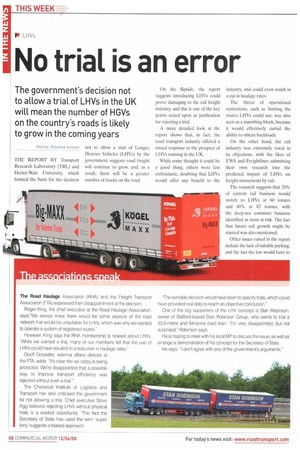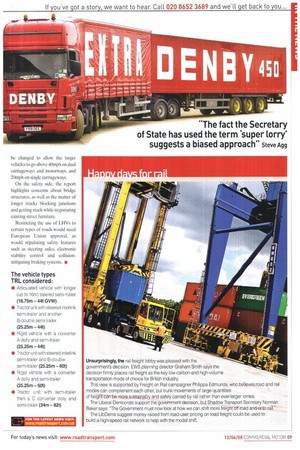No trial is an error
Page 8

Page 9

If you've noticed an error in this article please click here to report it so we can fix it.
The government's decision not to allow a trial of LHVs in the UK will mean the number of HGVs on the country's roads is likely to grow in the coming years
Words: Roanna Avisori THE REPORT BY Transport Research Laboratory (TRL) and Heriot-Watt University, which formed the basis for the decision not to allow a trial of Longer, Heavier Vehicles (LHVs) by the government suggests road freight will continue to grow, and, as a result, there will be a greater number of trucks on the road. On the flipside. the report suggests introducing LHVs could prove damaging to the rail freight industry. and this is one of the key points seized upon as justification for rejecting a trial.
A more detailed look at the report shows that, in fact, the road transport industry offered a mixed response to the prospect of LHVs running in the UK.
While some thought it could be a good thing, others were less enthusiastic, doubting that LHVs would offer any benefit to the industry, and could even result in a cut in haulage rates.
The threat of operational restrictions, such as limiting the routes LHVs could use, was also seen as a stumbling block, because it would effectively curtail the ability to obtain backloads.
On the other hand, the rail industry was extremely vocal in its objections, with the likes of EWS and Freightliner submitting their own research into the predicted impact of LHVs on freight movements by rail.
The research suggests that 20% of current rail business would switch to LHVs at 60 tonnes and 40% at 82 tonnes, with the deep-sea container business identified as most at risk. The fact that future rail growth might be stunted was also mentioned.
Other issues raised in the report include the lack of suitable parking, and the fact the law would have to be changed to allow the larger vehicles to go above 40inph on dual carriageways and motorways, and 20mph on single carriageways.
On the safety side, the report highlights concerns about bridge Structures, as well as the matter of longer trucks blocking junctions and getting stuck while negotiating existing street furniture.
Restricting the use of LHVs to certain types of roads would need European Union approval, as would stipulating safety features such as steering axles, electronic stability control and collisionmitigating braking systems. •
The vehicle types TRL considered:
• Articulated vehicle with longer (up to 16m) steered semi-trailer (18.75m — 441 GVW) • Tractor unit with steered interlink sen-trailer and another B-double semi-trailer (25.25m — 441) • Rigid vehicle with a converter A dolly and semi-trailer (25.25m — 441) • Tractor unit with steered interlink semi-trailer and B-double semi-trailer (25.25m — 60t) • Rigid vehicle with a converter A dolly and semi-trailer (25.25m — 60t) • Tractor unit with semi-trailer then a C converter dolly and semi-trailer (34m — 821)
















































































































































































